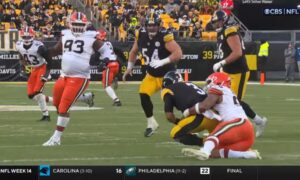During the broadcast of the Pittsburgh Steelers’ victory over the Jacksonville Jaguars, it was mentioned, after the home team had netted a field goal, that Pittsburgh has allowed their opponents to score on every opening drive thus far this season.
It happened Week One against the Cleveland Browns. After the Steelers scored a field goal, the Browns responded with a field goal of their own with the help of a 41-yard reception.
The next week, the Baltimore Ravens drove 85 yards after a fumble recovery—aided by two long gains via penalty—to score a touchdown and jump out to a seven-point lead that would have been sufficient for a victory on its own.
The following week, the Carolina Panthers got on the board first with an opening-drive field goal after the Steelers were forced to punt.
The Tampa Bay Buccaneers immediately recovered a fumble in Week Four and scored a seven-yard touchdown pass just two minutes into the game.
And as mentioned, the Jaguars jumped out ahead on Sunday after a Steelers punt as well.
That ignores the fact, however, that the Steelers have also given up a score on two of five second-half opening drives as well, meaning Pittsburgh’s opponents have opened up each half with points on seven of 10 occasions.
It seems to be feast or famine, as against the Ravens, the Steelers quickly forced a three-and-out after two plays for a loss and an incompletion. The possession ultimately led to a field goal.
The following week, the Panthers and Steelers exchanged penalties before Jarvis Jones notched a strip sack and Pittsburgh recovered, leading to a touchdown.
However, the Ravens, Panthers, and Jaguars all came back to score on their second drives, the former two being touchdowns.
The Browns and Buccaneers both kicked the doors down out of the locker rooms to begin the second half in their games. The Browns in particular put up three scoring drives, including two touchdowns, during the first 15:03 of the second half.
Tampa Bay, meanwhile, stormed down the field in two and a half minutes to open the third quarter the week before last and tied the game at 17.
It’s clear that the Steelers defense has struggled to get off to a fast start to begin play during the first halves of games, but it’s been true to start the second half as well, whether it came on the first or second drive.
The defense can’t afford to go through a warm up period in which they play themselves into the speed of the game. Slow starts have dug this team too many holes, some of which they were unable to climb out of, and others just barely.





